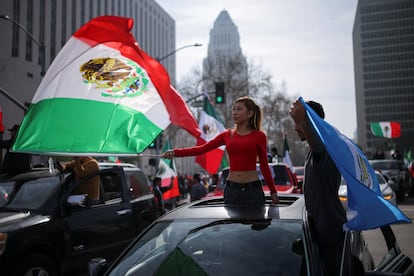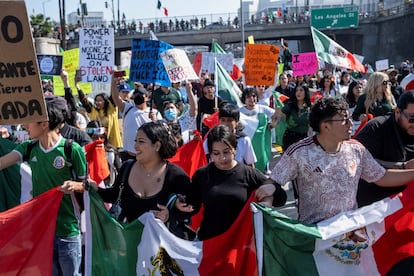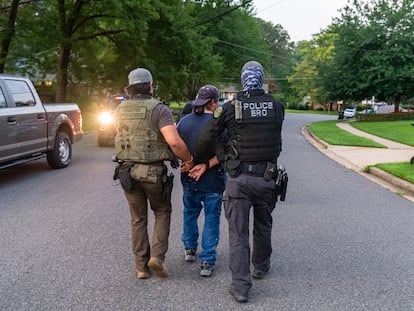Should the Mexican flag be flown at anti-Trump protests?
A new generation of activists is debating on social media whether the symbol’s presence is beneficial or not in the fight against the Republican’s measures


Fourth consecutive day of protests in the United States. Hundreds of people marched on Wednesday in the streets of Phoenix, Denver, Washington D.C. and L.A., among other cities, in repudiation of Donald Trump’s policies. Among the banners and the slogans, there is always an invariable presence at the demonstrations: the Mexican flag. Waving in several of the main cities of the country, the insignia has revived an old debate in these new times of fear and xenophobia promoted by the White House: is it beneficial or counterproductive for those demonstrating against Trumpism?
The main attacks have come from Trump’s allied media outlets. “LAPD surrenders streets to Mexican flag-waving protesters,” read a headline by Breitbart this week, in a story expressing disappointment at the authorities’ passivity in the face of the protests. Another radical outlet, The Washington Examiner, called the demonstrators “pro-illegal immigrant protesters.” “Evidently, the best way they can come up with to convince people that illegal immigrants should be Americans because they make the U.S. better is to wave the flags of a foreign nation that is exporting fentanyl and cartel members across our southern border,” noted one of its analysts.
The columnist, Zachary Faria, overlooked the fact that many of the protesters taking to the streets are already American citizens. The calls for the marches, spread and made viral on social media, asked undocumented immigrants to stay home so as not to risk being arrested in a mass raid. So these protests involve a large group of second- and third-generation immigrants.
It is not only the radical right that has highlighted the presence of the flags. “Do you really think that waving thousands of flags of Mexico, Honduras, Guatemala, El Salvador or Venezuela in the middle of U.S. cities is going to change public opinion in favor of our people?” the influencer Carlos Eduardo Espina recently asked his 12 million followers on TikTok. “It’s going to generate negative opinion. The average person in this country is going to think what the fuck is going on,” he said in a video with more than 100,000 likes and 13,000 comments.
The remarks by Espina, a Texas-based immigrant rights activist, prompted a discussion. “The people have come out with their flags is because they feel their culture has been attacked.... These young people, children of Mexican parents, are responding because Trump and white supremacists want to deport them, want to eliminate those cultures from this country,” responded Danny Diaz, a Mexican-American living on the Texas-Mexico border.

At least in the southern United States, the Mexican flag holds historical symbolism. David Correia, a professor of American Studies at the University of New Mexico, considers it a symbol of resistance since the late 19th century. In 1848, Mexico lost a third of its territory in the war against the United States. The agreement resulting from the conflict, the Guadalupe Hidalgo Treaty, contemplated that the Mexicans of New Mexico, Arizona, and California would be recognized as U.S. citizens. The promise was not kept. Many were victims of illegal land expropriation and discrimination.
Today’s groups of much younger activists are facing the same dilemma that activists have faced for decades: the use of the flag in an anti-immigrant and anti-Mexican cultural climate. Mexicans are the largest group of Hispanics living in the United States. There are about 37.2 million of them. In Los Angeles County alone, there are about 3.2 million Mexican-Americans.
One of these, Fernando Ayala, originally from the Mexican state of Michoacán, was selling flags on Wednesday in front of Los Angeles City Hall, the epicenter of the anti-Trump protests in the California city. “We are all human beings and we need equality and respect,” assured the street vendor, who was letting students buy his flags for half price, asking for between $5 and $40, depending on the size. Another vendor, Cristian from Guatemala, was selling his larger flags for up to $100. In his cart he also carried insignias from Guatemala, El Salvador and the United States.
Pride in one’s roots
The diplomat Carlos González Gutiérrez, Mexico’s consul in Los Angeles, believes it is a mistake to address the issue on the basis of whether or not the protesters show alliance to the United States by using other flags. “It is a symbol of the culture that gives them their identity and the roots where they come from, but they are, fundamentally, U.S. citizens who have lived all their lives in this country and who have no need to ever leave it. They carry those flags to make their pride in their identity explicit,” he says.
Mexican flags also flew in protest during Trump’s first presidency. But you have to go back to 1994 to find another moment of great political weight. On October 16, thousands of people took the Mexican flag to the streets of L.A. to repudiate Proposition 187, promoted by Governor Pete Wilson. It denied undocumented immigrants and their children access to public health and education, among other very important services such as driver’s licenses. The measure was approved at the ballot box by Californians, but was struck down by the courts.
Decades later, that series of mobilizations is considered the political awakening of Latinos in California. Los Angeles is today, along with many other cities, an oasis in the protection of undocumented immigrants. But its past of persecution of minorities is long.
During World War II, Latino youths who wore zoot suits, a style borrowed from Black communities, were frowned upon by whites. For them, dressing like this was an excess and an unpatriotic symbol. Tensions between Hispanic groups, known as pachucos, and white Angelenos, especially those doing their military service, boiled over in the summer of 1943.
There were then several attacks on young Chicanos, who were beaten and insulted because of their clothing. The police tolerated many of these attacks. When they did intervene, it was to arrest the victims. The episode is known in local history as the Zoot Suits riots. Eighty years later, the clothes no longer provoke controversy. But flags do.
Sign up for our weekly newsletter to get more English-language news coverage from EL PAÍS USA Edition
Tu suscripción se está usando en otro dispositivo
¿Quieres añadir otro usuario a tu suscripción?
Si continúas leyendo en este dispositivo, no se podrá leer en el otro.
FlechaTu suscripción se está usando en otro dispositivo y solo puedes acceder a EL PAÍS desde un dispositivo a la vez.
Si quieres compartir tu cuenta, cambia tu suscripción a la modalidad Premium, así podrás añadir otro usuario. Cada uno accederá con su propia cuenta de email, lo que os permitirá personalizar vuestra experiencia en EL PAÍS.
¿Tienes una suscripción de empresa? Accede aquí para contratar más cuentas.
En el caso de no saber quién está usando tu cuenta, te recomendamos cambiar tu contraseña aquí.
Si decides continuar compartiendo tu cuenta, este mensaje se mostrará en tu dispositivo y en el de la otra persona que está usando tu cuenta de forma indefinida, afectando a tu experiencia de lectura. Puedes consultar aquí los términos y condiciones de la suscripción digital.
More information
Archived In
Últimas noticias
Chris Martin, Taylor Swift, Elijah Wood and other famous wedding ‘crashers’
‘How does it feel to be a failure?’: Elizabeth Berkley’s journey from ‘Showgirls’ ridicule to vindication
The story of the Málaga virus: The code that haunted Google’s cybersecurity center director for 30 years
The impact of Ecuador’s mega-prison: A polluted river, cleared forests and military checkpoints
Most viewed
- Christian Louboutin: ‘Young people don’t want to be like their parents. And if their parents wear sneakers, they’re going to look for something else’
- The low-cost creative revolution: How technology is making art accessible to everyone
- Liset Menéndez de la Prida, neuroscientist: ‘It’s not normal to constantly seek pleasure; it’s important to be bored, to be calm’
- All the effects of gentrification in one corner of Mexico’s Colonia Roma
- December Social Security and SSI payments: Dates, double checks and the 2026 COLA increase










































